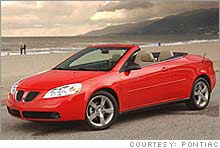|
Convertibles: Now better than ever Top-down cars are tempting. The good news is there's a lot less to worry about. NEW YORK (CNNMoney.com) -- Seeing more of your fellow drivers lately? That could be because there are more convertibles out there. Carmakers are introducing new drop-tops all the time, it seems, and they're getting cheaper, too. The Pontiac G6 convertible is hitting streets now, billed by General Motors as the cheapest hard-top convertible. Coming soon, Volkswagen is introducing a competitor, the Eos, a hard-top convertible with a sunroof.
If you're considering buying a convertible, there are some things you should know. If your friends have been warning you away with ragtop horror stories from their younger days - leaks, roofs stuck halfway up, awful road and wind noise - you should know that convertibles have gotten a lot better. "They're no longer the MGs and Triumphs of yesteryear," said David Champion. For the most part, today's convertible tops seal shut well, locking out the leaks and highway wind noise that used to plague convertibles. "Cowl shake," the twisting of the car's body over bumps, used to be an accepted part of driving a convertible. That was because a hard-top car's roof offered structural support to the entire body. Taking it away meant the body flexed easily. Today, most convertible cars have enough built-in strengthening to keep their bodies rigid even without a roof. In higher-priced convertibles, at least, weather isn't as much of impediment as it used to be. A few luxury convertibles offer ventilated seats that gently blow air on your back and thighs. The Mercedes-Benz SLK two-seater offers a feature called the Air Scarf that blows warm air around your neck to keep you feeling toasty on cool days. Heated seats are also increasingly common. Combined with a wind screen that goes behind the seats to create a sort of "bubble" of still air, a car's heater and heated seats can make top down driving on a cool day comfortably feasable, said Rik Paul, autos editor for Consumer Reports. "The Air Scarf, then, is just icing on the cake," he said. Downsides Lack of space is one of the drawbacks of a convertible. When that top is down, it has to be stored somewhere. Usually that means space is taken away from the trunk and, almost always, the back seats. (In many convertible cars, you have to choose between using the trunk to store your luggage or your roof. It may not do both at the same time.) In some cars that lack a trunk, like the Mini Cooper Convertible, the top simply folds up at the back. It doesn't take up much space that way, but it does impair rear visibility. Because of the extra structural support they require and because of the machinery needed to raise and lower the roof, convertibles also weigh more than hard-top cars. That means performance is a bit more sluggish and fuel economy can also be affected. Supposedly offering the best of both cars, so-called hard-top convertibles are becoming increasingly common and less expensive. These cars have roofs made up of solid sections. They offer a cleaner look when the top is up and greater security against theft and vandalism. Hard-top convertibles have their own issues, though. For one thing, a hard roof takes up more space when stowed away. They also generally weigh more. Safety In spite of all the improvements, there are still some inherent safety issues in a convertible. "A convertible is likely to be less crashworthy than the same model with a hard top," said Russ Rader, a spokesman for the Insurance Institute for Highway Safety. Without a roof, it's harder to engineer a strong "safety cage" around vehicle occupants. Rollover protection is another obvious issue. Hard-top convertibles don't solve this problem. Even if it looks solid, a hard convertible top isn't going to have nearly the strength of a permanent roof. In the event the vehicle flips over, it will offer little protection. While rollovers in passenger cars are relatively rare, and a convertible's lower center of gravity offers a degree of protection, some convertibles now have rollover protection systems. These combine strengthened windshield frames with metal bars that deploy from behind the rear seats the moment sensors detect an imminent rollover. In any vehicle, it's important for occupants to use safety belts. It can be particularly important for those in a convertible, though, because of the greater risk of being thrown from the vehicle in what might otherwise be a relatively minor crash. Ownership costs Reliability for convertibles, as compared to hard-top cars, is similar, according to IntelliChoice.com, a Web site that tracks the ownership costs of cars. Most convertibles these days have power tops. Only the least-expensive convertibles, like the Mazda Miata, Pontiac Solstice and Saturn Sky, have fully manual tops. Electric motors that operate power tops can fail and cause problems as they age, said Consumer Reports' Champion. Whether you buy a coupe or convertible doesn't materially effect resale values, according to data from IntelliChoice.com. Ownership costs are only slightly higher because of the added repair and maintenance costs for the convertible top and the related machinery. Insurance costs for convertibles are also about the same as for otherwise similar hard-top cars, according to IntelliChoice.com. So, if you're thinking of buying a convertible, and the weather where you live will let you get enough use out of it to be worth the cost, there's really not too much holding you back. Gallery: Convertibles sampler Volvo vs. Saab: Swedish models take their tops off Edmunds: Top 10 car deals for August |
|

